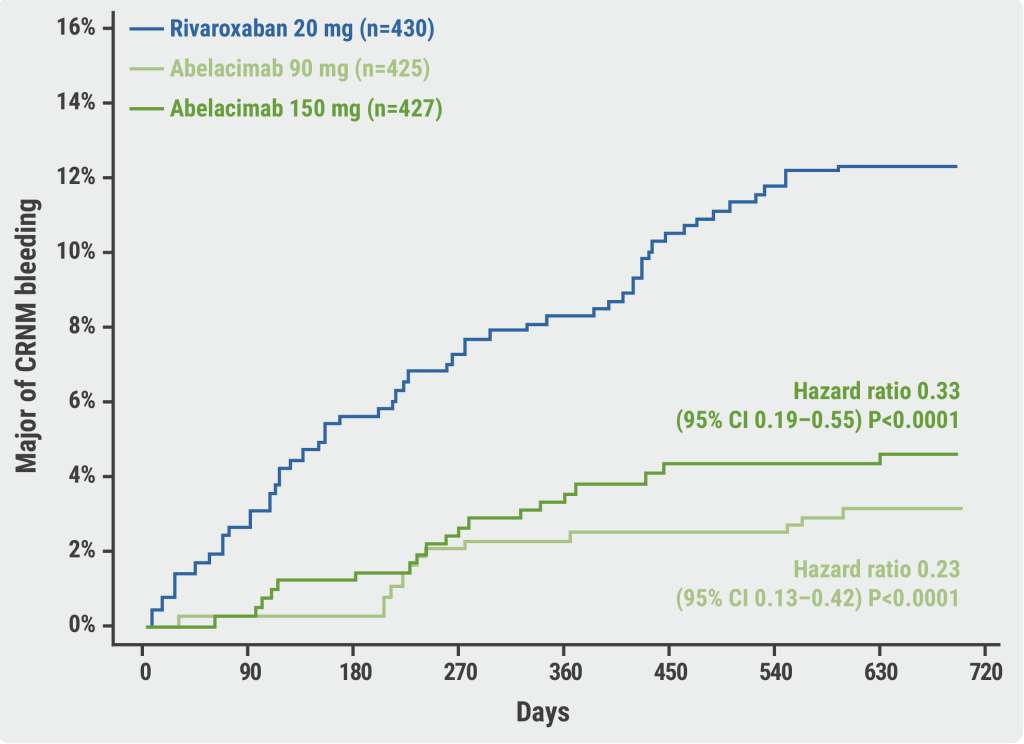https://doi.org/10.55788/b8cbaa10
The multicentre PREVENTIVE-VT trial (NCT03421834) randomised participants to either preventive ablation plus ICD or ICD alone [1]. Participants were required to have a primary ICD indication and were excluded if they were eligible for revascularisation or if they had documented ventricular arrhythmia. The aim of each ablation was the complete elimination of abnormal ventricular electrograms after high-density remapping and ventricular tachycardia non-inducibility. The primary outcome was event-driven; time to ICD implantation or ventricular arrhythmia-related hospitalisation. Included were 60 participants, with 30 assigned to each treatment strategy, with a mean follow-up of 44.7 months.
In the ICD-alone group, 13 primary outcome events were observed, while 5 events were observed in the preventive ablation group, corresponding to an HR of 0.33 (95% CI 0.12–0.94; P=0.037). Furthermore, preventive ablation led to a reduction in participants with electrical storms (0% vs 20%; P=0.01) and unplanned hospital admissions for symptomatic ventricular arrhythmia (0% vs 30%; P=0.001). Two major catheter ablation complications were reported, being a complete atrioventricular block and an ischaemic stroke.
Dr David Žižek (University Medical Centre Ljubljana, Slovenia) concluded that “preventive ablation of the infarct-related artery chronic total occlusion substrate at the time of ICD implantation is associated with a reduced risk of appropriate ICD therapy or ventricular arrhythmia-related hospitalisation.”
- Žižek D, et al. Impact of preventive substrate catheter ablation on implantable cardioverter-defibrillator interventions in patients with ischaemic cardiomyopathy and infarct-related coronary chronic total occlusion. Late-Breaking Science: ablation. EHRA Congress 2024, 7–9 April, Berlin, Germany.
Copyright ©2024 Medicom Medical Publishers
Posted on
Previous Article
« ASTRO AF: No benefit of staged left atrial appendage isolation cryoballoon ablation over radiofrequency ablation Next Article
Style-AF: Improved outcomes with vascular closure versus figure-of-eight suture »
« ASTRO AF: No benefit of staged left atrial appendage isolation cryoballoon ablation over radiofrequency ablation Next Article
Style-AF: Improved outcomes with vascular closure versus figure-of-eight suture »
Table of Contents: EHRA 2024
Featured articles
PIRECNA: Cardioneuroablation is feasible for vagally-induced atrioventricular block
ARTESiA: Stroke risk unaffected by subclinical atrial fibrillation duration
Personalising Ablation Techniques
Ablate-by-LAW: CT-determined left atrial wall thickness for ablation titration in atrial fibrillation
Personalised LAWT-guided ablation non-inferior to CLOSE protocol for paroxysmal atrial fibrillation
Style-AF: Improved outcomes with vascular closure versus figure-of-eight suture
Advantage of PREVENTIVE ablation plus implantable cardioverter-defibrillator in ischaemic cardiomyopathy
ASTRO AF: No benefit of staged left atrial appendage isolation cryoballoon ablation over radiofrequency ablation
Innovative Ablation Strategies
Pulsed-field ablation vs high-power short-duration radiofrequency in paroxysmal AF
CryoCure-VT: Endocardial ultra-low temperature cryoablation effective in sustained monomorphic ventricular tachycardia
PIRECNA: Cardioneuroablation is feasible for vagally-induced atrioventricular block
MRI head-to-head comparison of lesion quality following various ablation techniques
“Single-shot” conformable catheter shows promising efficacy in paroxysmal atrial fibrillation
Post-Ablation Recurrence
AF burden versus classical AF classification in predicting arrhythmia recurrence
ARTESiA: Stroke risk unaffected by subclinical atrial fibrillation duration
Ablation strategy and the number of repeat procedures not associated with atrial fibrillation recurrence
Factors associated with negative outcomes in post-operative atrial fibrillation
Arrhythmia Technologies
Smartphone rhythm monitoring optimises AF management following cardiac surgery
SMART-AV and SMART-CRT: Improved cardiac outcomes with algorithm-adapted atrioventricular delay
Premature battery depletion can affect a quarter of subcutaneous cardioverter defibrillators
New atrial fibrillation associated with a high risk of major cardiovascular outcomes
Related Articles

February 17, 2021
Vitamin D or omega 3 fatty acids do not prevent AF
© 2024 Medicom Medical Publishers. All rights reserved. Terms and Conditions | Privacy Policy
HEAD OFFICE
Laarderhoogtweg 25
1101 EB Amsterdam
The Netherlands
T: +31 85 4012 560
E: publishers@medicom-publishers.com

